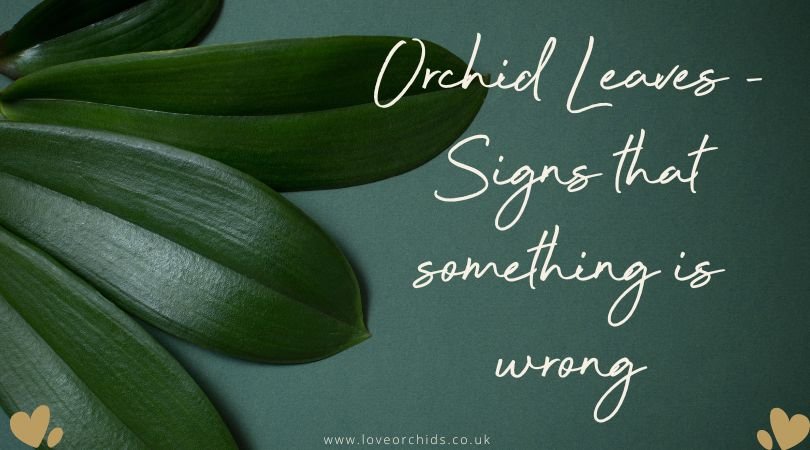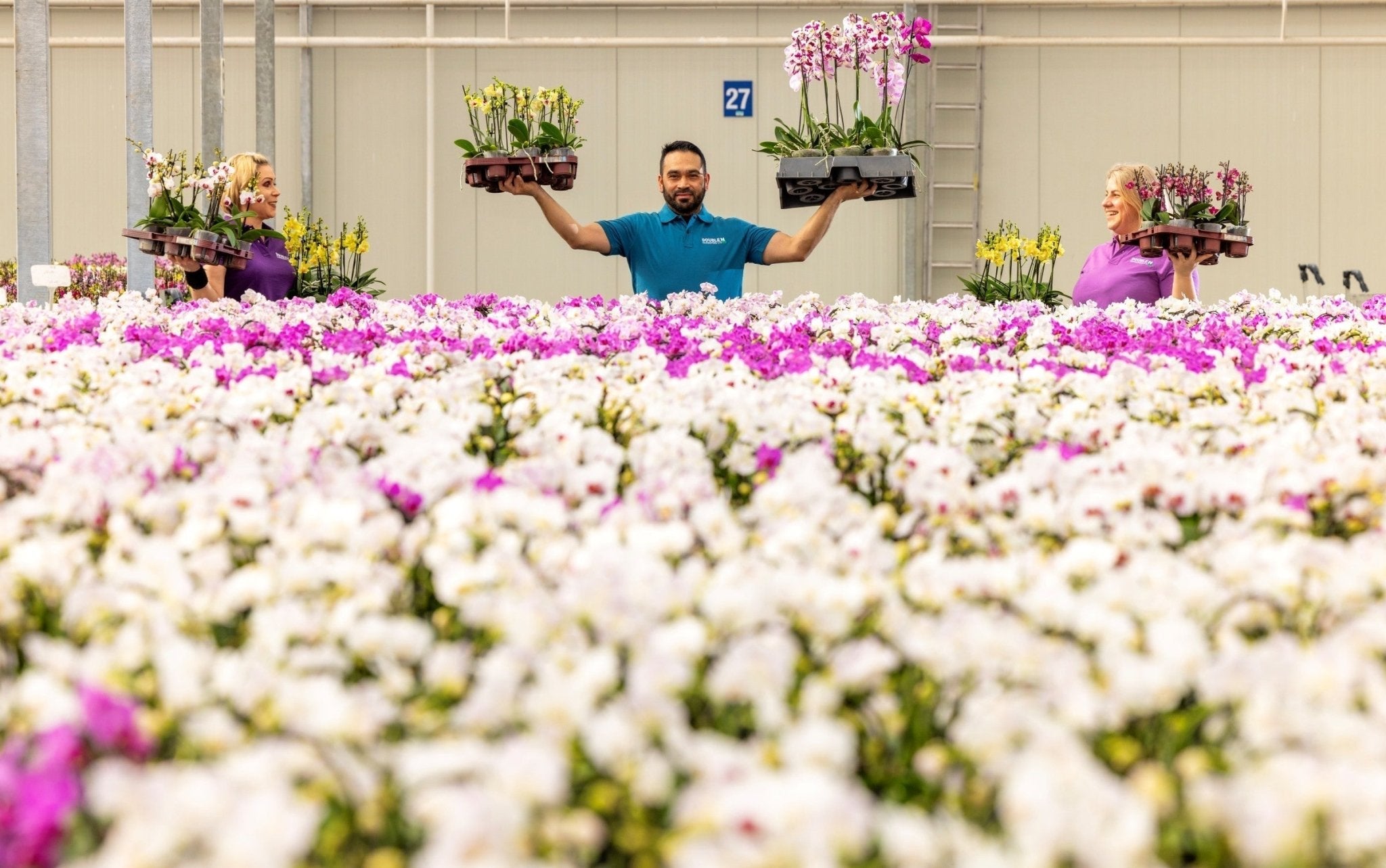Orchid Leaves - Signs That Something's Wrong

Reading Your Orchid's Leaves:
The leaves of your orchid can be a great source of useful information about the health of your plant. Identifying signs of orchid distress, as well as understanding the implications of changes in the appearance of your plant's leaves, can enable you to detect any existing problems and intervene before they seriously affect the health of your orchid.
Want to ensure your orchids are in tip-top shape? Here are some tell-tale signs to watch out for!
Signs of Unhealthy Orchid Leaves
Yellowing leaves: While it is fairly common for the bottom leaf to turn yellow and fall off over time to allow room for a new leaf to grow, yellow leaves could also be a sign that your orchid is receiving too much light, has endured some low temperatures, or has started to develop root rot due to over-watering. You should assess your orchid's surroundings and check its roots to further gauge the issue. An orchid with root rot will have slimy brown/mushy roots while healthy roots will be plump and green.
Very dark green leaves: Your orchid is probably not getting enough light. You should move it to a place where it receives plenty of bright, indirect sunlight and monitor for a while after.
White leaves: Your orchid is most likely receiving too much sunlight. Move it to an area that does not sit in bright, direct sunlight.
Limp, wrinkled, or torn leaves: This is a sure sign of dehydration in your plant. Look to increase your watering for a while and inspect your orchid's roots for signs of stress. Healthy hydrated roots should be firm and green while dehydrated roots will be white, brown, or shriveled.
Purple or reddish leaves: If the tops of orchid leaves turn reddish (reddish undersides are often normal), your orchid may be suffering from sunburn or a nitrogen or phosphorus deficiency. Move your orchid away from direct sunlight and apply fertilizer.
Signs of Healthy Orchid Leaves
Orchid leaves should be green, firm, and rubbery
Leaves are uniformly green, and not hugely varying in colour from each other.
Aerial roots are silvery/white and have green shiny tips. Multiple air roots are a good sign that your orchid is actively growing!
Potting mix is barely moist, and not bone dry or dripping wet
Common Questions;
Why Are My Orchid's Leaves Wrinkled?
The presence of wrinkles on orchid leaves does not necessarily indicate that the plant is beyond saving. Wrinkled leaves just indicate a problem. As soon as you notice the problem and the quicker you act, the higher chance you have to fix the issue and keep your plant healthy.
Wrinkled leaves often indicate problems with plant care. Wrinkled leaves can be caused by bacterial infections, but more commonly stem from issues with water, sunlight, and nutrients. By observing carefully, it is possible to identify the issue affecting your orchid and implement necessary changes for its recovery.
How do I know if I'm Watering Correctly?
To determine if over-watering or under-watering is the problem, it is recommended to inspect the root system of an orchid if you notice the leaves becoming limp. New houseplant owners often think that wilted leaves are a result of insufficient watering, but in reality, it's more typical for beginners to over-water their plants. Too much water can be just as harmful to your plant as too little water.
Over-watering;
Brown, mushy, or rotted roots may indicate over-watering of an orchid. Over-watering orchids can lead to suffocation of the roots, which then affects their ability to transport water and nutrients, resulting in leaves that become wrinkled.
Wait for the orchid's growing medium to become dry before watering again. It is recommended to use sterilized scissors when removing rotten roots and treating them with a root supplement. If there are sufficient healthy roots remaining, the leaves of the orchid have a decent chance of recuperating.
Under-watering
Under-watering can also cause wrinkled leaves. Leaves that are wrinkled due to under-watering have a leathery texture, but it is recommended to examine the roots for confirmation of the issue. Orchid roots that aren't getting enough water will look dry, brittle, or shriveled.
The roots are unable to distribute water and nutrients throughout the plant due to lack of water available to it.
To revive an orchid that has not been watered enough, you can try bottom watering the plant. Fill a tray/dish with around an inch of water, place the orchid in the water, and allow it to soak for 20 minutes before removing. This will help the roots to re-hydrate and allow the potting mix to soak up as much water as possible. Try to keep to a regular watering schedule.
An orchid that has been under-watered can recover with proper watering, as long as enough healthy roots remain.

What's the best temperature for my orchid?
Despite their tropical origins, orchids can be negatively affected by excessive heat and cold. Depending on the type of orchid you have, your orchid may prefer a temperature of anywhere from 18-30 degrees Celsius.
Heat levels that consistently fluctuate above or below this preferred temperature range can cause stress to your plant, resulting in dying leaves.
How Much Sunlight Does My Orchid Need?
The amount of sunlight required by orchids varies depending on the type, but excessive direct sunlight can damage their leaves. When an orchid leaf is burned, the breakdown of chlorophyll causes the appearance of discolored spots such as red, purple, yellow, or brown on the leaves.
You can't get rid of these damaged spots once they have happened. However, as soon as you notice signs of leaf burn, you should move the orchid out of direct sunlight to stop any more burns from occurring. Many orchid owners will use a sheer curtain to allow orchids to get enough sunlight while being shielded from the harsh direct light.
How do I know if my Plant Lacks Nutrients?
Wrinkled orchid leaves may be caused by a deficiency in nutrients. The lack of nutrients is often caused by root damage, which hinders the transportation of nutrients throughout the plant. In some cases the issue is that the potting mix no longer contains enough nutrients to feed the plant. Orchids only have access to a small amount of growing medium, and over time, the nutrients in this potting medium are used up or rendered unusable due to over-watering.
To help your orchid, small amounts of fertiliser can be good, but be careful of adding too much fertiliser, as this can damage the roots and hurt your orchid's overall health. We always recommend to dilute your fertilser as it is far more harmful to add too much than not enough.








